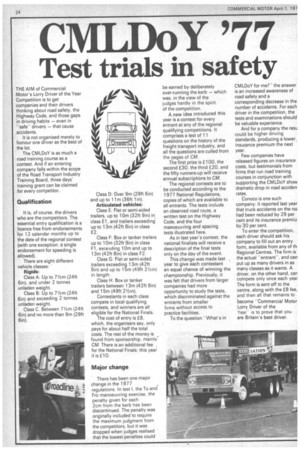CMLD6Y '77
Page 26

If you've noticed an error in this article please click here to report it so we can fix it.
Test trials in safety
THE AIM of Commercial Motor's Lorry Driver of the Year Competition is to get companies and their drivers thinking about road safety, the Highway Code, and those gaps in driving habits — even in "safe" drivers — that cause accidents.
It is not organised merely to honour one driver as the best of the lot.
The CMLDoY is as much a road training course as a contest. And if an entering company falls within the scope of the Road Transport Industry Training Board, three days' training grant can be claimed for every competitor.
Qualification
It is, of course, the drivers who are the competitors. The essential entry qualification is a _licence free from endorsements for 12 calendar months up to the date of the regional contest (with one exception: a single endorsement for speeding is allowed).
There are eight different vehicle classes: Rigids: Class A: Up to 71/2m (24ft 6in), and under 2 tonnes unladen weight.
Class B: Lip to 71/2m (24ft 6in) and exceeding 2 tonnes unladen weight.
Class C. Between 71/2m (24ft 6in) and no more than 9m (29ft 6in). Class D: Over 9m (29ft 6in) and up to llm (36ft lin). Articulated vehicles: Class E: Flat or semi-sided trailers, up to 10m (32ft 9in) in class El, and trailers exceeding up to 13m (42ft 8in) in class E2.
Class F: Box or tanker trailers up to 10m (32ft 9in) in class Fl, exceeding 10m and up to 13m (42ft 8in) in class F2.
Class G: Flat or semi-sided trailers exceeding 13m (42ft 8in) and up to 15m (49ft 21/2in) in length.
Class H: Box or tanker trailers between 13m (42ft 8in) and 15m (49ft 21/2in).
Contestants in each class compete in local qualifying contests, and winners are all eligible for the National Finals.
The cost of entry is £8, which, the organisers say, only pays for about half the total costs. The rest of the money is _ found from sponsorship, mainly CM. There is an additional fee . for the National Finals; this year it is £10.
Major change
There has been one major change in the 1977 regulations. In test I. the To and Fro manoeuvring exercise, the penalty given for each 2cm from the kerb has been discontinued. The penalty was ,originally included to require the maximum judgment from the competitors, but it was dropped when judges realised that the lowest penalties could be earned by deliberately over-running the kerb — which was, in the view of the judges hardly in the spirit of the competition.
A new idea introduced this year is a contest for every entrant at any of the regional qualifying competitions. It comprises a test of 11 questions on the history of the freight transport industry, and all the questions are culled from the pages of CM.
The first prize is £100, the second £30, the third £20, and the fifty runners-up will receive annual subscriptions to CM.
The regional contests are to be conducted according to the 1977 National Regulations, copies of which are available to all entrants. The tests include an observed road route, a written test on the Highway Code, and the four manoeuvring and spacing tests illustrated here.
As in last year's contest, the national finalists will receive a description of the final tests only on the day of the event.
This change was made last , year to give each contestant an equal chance of winning the championship. Previously, it was felt that drivers from larger companies had more opportunity to study the tests, which discriminated against the entrants from smaller firms without access to practice facilities.
To the question "What's in CMLDoY for me?" the answer is an increased awareness of road safety and a corresponding decrease in the number of accidents. For each driver in the competition, the tests and examinations should be valuable experience.
And for a company the resu could be higher driving standards, producing a lower insurance premium the next year.
Few companies have released figures on insurance costs, but testimonials from firms that run road training courses in conjunction with supporting the CMLDoY show dramatic drop in road acciden rates.
Conoco is one such company: it reported last year that truck accidents on the roE had been reduced by 29 per cent and its insurance premlui by 30 per cent.
To enter the competition, each driver should ask his company to fill out an entry form, available from any of th Regional Centres. The firm is the actual "'entrant", and can put up as many drivers in as many classes as it wants. A driver, on the other hand, can compete only once each year The form is sent off to the centre, along with the £8 fee, and then all that remains to become "Commercial Motor Lorry Driver of the Year' is to prove that you are Britain's best driver.
































































































